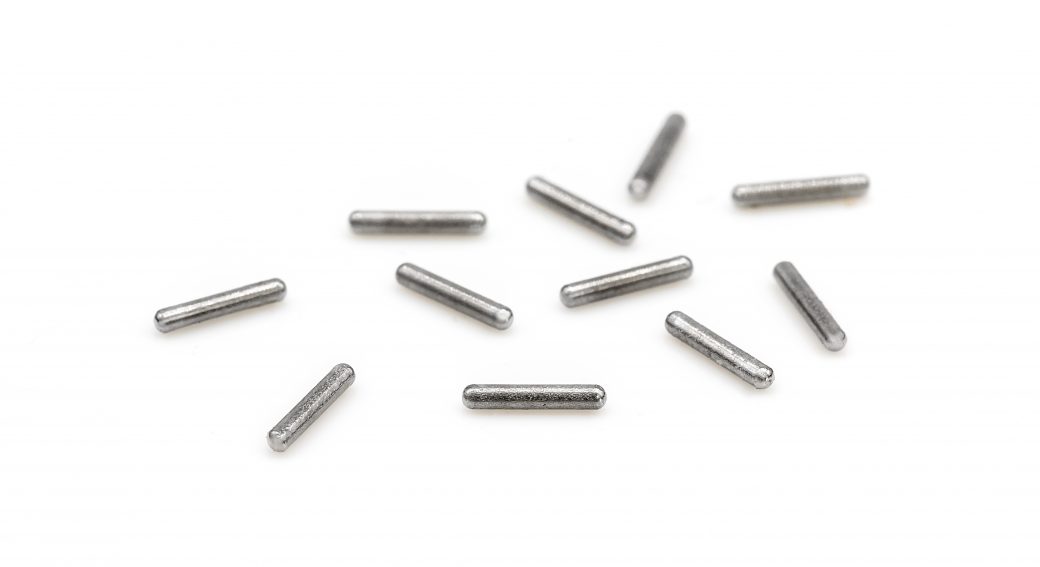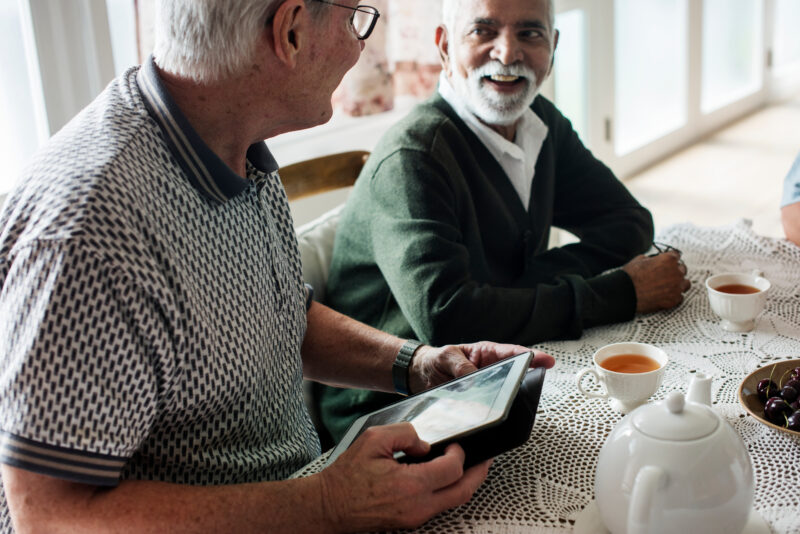LDR brachytherapy: Your questions answered
Here we aim to answer some of the most commonly asked questions about brachytherapy in the treatment of prostate cancer. If you’ve decided that brachytherapy might be the right treatment for you, or a loved one, we’ve also included some information on what to ask your doctor or brachytherapy specialist at your next appointment.
Visit our Facebook page to join a community of patients interested in LDR brachytherapy.
Can the seeds come loose after implantation?
This is possible, but it is very rare. In the highly unlikely event that you pass a loose seed in your urine and can see it in the toilet bowl, the best course of action is to remove it with a pair of tweezers and place it in a sealed container. You should then contact your hospital who will provide advice for safe disposal.

What side effects could I have when I get home?
You may experience some discomfort after a week or more when the radiation from the seeds starts to take effect in the lower urinary tract (lower parts of the tube through which you pass urine). You may also have some mild discomfort as a result of the needle punctures. You can use a simple painkiller such as paracetamol at home to relieve these effects, but it’s important not to take aspirin. Aspirin thins the blood and this could make any bruising or bleeding you have worse. You may see some bruising near your scrotum or underneath it, and the discolouration may rarely spread to your upper thighs. This will start to disappear after 1-2 weeks. You should be aware that your urine may be blood-stained for several days after the implant procedure. This may be alarming at first but it should clear up on its own. If blood continues to appear in your urine you should contact the hospital.
What can I do to minimise side effects at home?
There are number of simple precautions you can take to make you feel more comfortable at home for the first few months after LDR brachytherapy. If you eat high-fibre foods and fruit regularly this will keep your bowel motions loose. You should drink 1½ to 2 litres of fluids each day to help to flush out your urinary system, although you should limit your fluids after 7.00 at night (especially coffee, tea and alcohol). This will help to reduce the amount of urine produced during the night and decrease the number of times you will have to get up to go to the toilet.
What about my sex life after brachytherapy?
Sexual intercourse should be avoided for the first 2 weeks after your procedure because there is a very slight risk that one of the seeds could come out when you ejaculate (in your semen). You should use a condom for the first two or three times you have sex for this reason. If you are unsure about when you can stop using a condom, your consultant or a member of your care team at the hospital can advise you on this. On the first few occasions you have sex, you may have some mild discomfort or irritation during, or immediately after intercourse, and your semen may be discoloured due to the internal bleeding that may have occurred during the implant procedure. Impotence – the inability to achieve a satisfactory erection – is a side effect of all prostate cancer treatments but it occurs less often following brachytherapy compared with surgery or external beam radiation, and usually responds well with treatment, e.g. a PDE5 inhibitor such as Viagra, Cialis or Levitra, which will be available on the NHS. Talk to your consultant or GP about obtaining a prescription.
How long will it take to return to my normal daily activities after LDR brachytherapy?
Most patients return to driving within a few days. Usually driving is not recommended until 2 days after anaesthesia and you should check your motor insurance policy to ensure no restrictions apply after medical treatment. The majority of men are back at work within 3-5 days, although the delay may be a little longer if you have a job which involves lifting or a lot of physical activity, e.g. fireman, builder.

What about my ability to pass urine after brachytherapy?
After LDR brachytherapy you can expect some side effects related to your ability to pass urine. These urinary side effects can take up to 3-6 weeks to develop, and the symptoms are usually mild-to-moderate in how much they affect you. The effects can include discomfort or pain during urination (called dysuria), an increased frequency (‘need to go’) and a poor urine stream (reduced volume). These symptoms tend to peak at about 3-4 months, but by 6-9 months should be improving. One year after brachytherapy, about 90 out of every 100 men (90% of patients) will have returned to pre-procedure levels with respect to their ability to pass urine.
Incontinence (loss of control) after brachytherapy is very rare and is usually transient. Urine retention (a build-up of urine in the bladder that is difficult to release) is also uncommon; it occurs in about 10-15 out of every 100 men (10-15% of patients) after LDR brachytherapy, and some of these patients may require a catheter (5%) to help them pass urine. However, urinary side effects are less frequent following brachytherapy than with surgical intervention and treatment with external beam radiation.
What medication can I expect after LDR brachytherapy?
After the implant procedure, you will receive a course of antibiotics to prevent infection, and tablets to help you pass urine (these are called alpha-blockers). You should continue to take the full course of these medicines and follow the instructions that will be provided with them. If you need more tablets after you get home you should visit your GP to get a prescription. You may also receive medication to soften your stools while you are in hospital, to make opening your bowels easier. If you are in pain immediately after the procedure you will be given medication to ease this as well.
If I have LDR brachytherapy do I become radioactive?
No. Once you have had the seeds implanted you do not become radioactive yourself; it’s only the seeds that are radioactive – not you! Most of the radiation is released into the prostate gland over the first 3 months and they continue to be biologically active for about 9 months in total. After that they are effectively inactive and they remain in the prostate as there is no need to remove them. You will not be a hazard to your family and friends so there are no restrictions on being with them, although, as a precaution doctors recommend that you should avoid a long cuddle with a young child, or a pregnant woman, during the first 2 months after your implant procedure.
If I have LDR brachytherapy will I have to have any other procedures as well?
This depends on your assessment in hospital and the extent of the cancer in your prostate gland. Sometimes LDR brachytherapy is carried out with external beam radiation, and the consultant in charge of your treatment will advise on what will be the best treatment approach for you. For patients with a large-volume prostate, hormone treatment may be necessary to shrink the size of the prostate gland before LDR brachytherapy can be done. A further important consideration is that when you have had LDR brachytherapy you can still have surgical treatment at a later stage, if this is considered necessary by your consultant.
If I have already had surgery on my prostate gland can I have LDR brachytherapy?
If you have had a radical prostatectomy and your prostate gland removed, brachytherapy cannot be done because there is no prostate gland tissue to accept the seed implants. If you have had less extensive surgery, i.e. transurethral prostate surgery (often abbreviated to TURP), LDR brachytherapy may still be an option for you, and your consultant or another member of the hospital care team will advise you on this.
If I have LDR brachytherapy and my prostate cancer comes back, can I have further treatment?
Yes. Following brachytherapy you will return to the hospital for an examination after 4-6 weeks, and then periodically as determined by your doctor (every 6 months or every year, for example). PSA levels are checked and any side effects discussed. Some tests may be done to measure how fast your urine is flowing and learn what amount is left in the bladder following urination to check how well your bladder is working. Repeat x-rays may be done at some of the follow-ups. A repeat prostate biopsy may also be done. If abnormal results are found during these follow-up visits then your doctor and nurse will assess the best course of treatment and will discuss it with you.
When was LDR brachytherapy first performed?
LDR brachytherapy as a treatment for prostate cancer was developed in the USA. The latest techniques were developed in the mid-1980s and the first UK procedure took place in Leeds in 1995. There is now considerable and growing experience of this procedure around the world. Currently, approximately 2,000 procedures are performed each year in the UK and new centres continue to open. The procedure has been available for considerably longer in the USA, where between 30-50% of patients with localised prostate cancer now choose this form of treatment.
Questions to ask your doctor: Getting the most out of your appointment
“Questions to ask” – has been developed by the UK’s Department of Health to help everyone get the best out of their appointment.
We know that shared decision making between patients and professionals can make a lasting and significant difference to healthcare outcomes. Receiving and understanding the right information during an appointment is key to involving people in decisions about their treatment and care. “Questions to ask” supports this involvement by helping people with general questions during a consultation, such as “Are there any side effects or risks?” and “How will I know if the treatment is working?”
“Questions to ask” is available in a number of formats, posters, easy read, large print, audio, braille and a two-sided A5 leaflet. Translations of the leaflet are available in Arabic, Bengali, French, Gujarati, Somali, Portuguese, Polish, Punjabi, Spanish and Urdu.
Questions to ask your brachytherapy specialist
- Will I be given hormone treatment prior to brachytherapy? If yes, why? If not, why not?
- How long does the procedure take?
- How many of these procedures do you do a year?
- Will I require external beam radiotherapy as well as brachytherapy?
- In your experience, how successful is this procedure?
- What are your results in respect of impotence and incontinence?
- How long will I be in hospital?
- Will I have much pain after the implant and how will the pain be controlled?
- How soon is my follow-up appointment after discharge, and when will the PSA first be measured?
- How often will my PSA be checked?
- What should the PSA be after brachytherapy? What would it mean if it doesn’t reach that level? What would you do then?
Downloadable Content
Join the conversation
Have you been diagnosed with prostate cancer?
We’d appreciate 5 minutes of your time to answer our questionnaire

